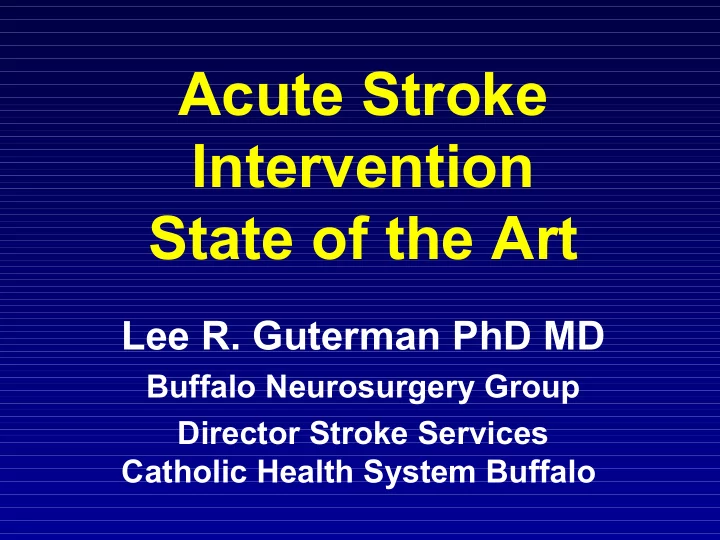

Acute Stroke Intervention State of the Art Lee R. Guterman PhD MD Buffalo Neurosurgery Group Director Stroke Services Catholic Health System Buffalo
Conflicts No financial Interest in Any Drugs or Devices in my presentation
Time Window for Treatment • 0-3 IV therapy • 0-6 IA therapy • 0-8 mechanical revascularization Loosely based on cerebral perfusion data in primates
FIBRINOLYTICS (INTRAVENOUS) tPA for acute ischemic stroke. NINDS trial 624 patients with ischemic stroke within 3 hours Intravenous tPA (0.9 mg/kg) vs placebo Follow-up 3 months tPA placebo 47% 39% Improvement at 24 h Favorable outcome at 42% 27% 3 m (Rankin scale) Intracerebral hemorrhage 6.4% 0.6% 17% 21% Death at 3 m
Patient treated with IV tPA had a relative 30% greater likelihood of having minor or no deficit at 3 months based on Rankin score true for all subgroups
Role for IV tPA 0-3 hours NIHSS < 12 less severe strokes that present early after onset
Ultrasound-enhanced systemic thrombolysis for acute ischemic stroke Alexandrov et al NEJM 2004 • 2 MHz TCD focused on occluded intracranial vessel • 126 patients with acute stroke two groups ultrasound vs placebo • Complete recanalization or dramatic clinical recovery within two hours • 49% (31pts) vs 30% 19pts (p=0.03) • 42% vs 29% 3 month favorable outcome – (P=0.2)
Microbubble tPA, TCD Molina et al stroke Feb 2006 • 38 pts tPA TCD monitoring plus 3 doses of 2.5 g (400 mg/mL) of galactose-based MBs given at 2, 20, and 40 minutes after tPA bolus (MB group). • Two-hour complete recanalization rate was significantly (P=0.038) higher in the TCD group • tPA/US/MB group (54.5%) • tPA/US (40.8%) • tPA (23.9%) groups .
3 – 20 % of patients arrive within a 3 hr window
FIBRINOLYTICS (INTRA-ARTERIAL) Prolyse in Acute Cerebral Thromboembolism (PROACT) II 180 patients with occlusion of middle cerebral artery within 6 hours of onset Intraarterial Prourokinase (9mg) vs placebo Follow-up 3 months Prourokinase Placebo Recanalization 66% 18% Hemorrhagic 10% 2% transformation 40% 25% Favorable outcome
Treated patients had a 60% relative increase in good or excellent outcome Rankin 0-2
EMS BRIDGING TRIAL • 53% recannalization in the IV/ IA tPA group • 28 % IA tPA alone • No clear difference in outcome between the groups
Minimize reperfusion hemorrhage
Qualitative or Quantitative test of brain tissue viability
PERFUSION IMAGING
MRI
The apparent diffusion coefficient of water is decreased in areas of ischemia
MRI Diffusion/Perfusion Kidwell: Stroke, Volume 34:2729-2735, Nov 2003
Magnetic Resonance TIME MOTION RESOLUTION cerebellum and brainstem
CT
Ischemic Penumbra
Size of Infarct Zone predictive of Intracranial Reperfusion Hemorrhage
Reperfusion Hemorrhage
Outcome Driven by Volume Ratio Infarct volume _______________ Ischemic Penumbra volume
Mechanical Thrombolysis Concentric Merci Retriever Thrombus Retriever X5
Basilar Occlusion 24 yr male NIHSS 16
Basilar Occlusion
Merci Registry • 141 patients • 46% female • Mean Age 67 • Mean Baseline NIHSS 20 • Mean Treatment time approx 4 hrs
Baseline NIH Stroke Scale (n=140*) NIHSS 8-10 (4) NIHSS 11-20 (76) 3% 54% NIHSS >20 (60) 43% *Baseline NIHSS not recorded for 1 Patient
Occlusion Location (n=141) Vertebral (1) 1% Basilar (13) 14% 9% ICA-T (20) ICA (27) 19% 57% MCA (80)
MERCI TRIAL RECANNLAIZATION • Retriever alone 48% • Retriever plus adjunctive 60%
Good Outcome (90-Day mRS ≤2) Good Outcome (90-Day mRS ≤2) By Revascularization Status By Revascularization Status 50% 46% 45% 45% p< 0.0001* 29/63 p< 0.0001* 35/78 40% 35% 28% 30% 36/130 25% 20% 15% 10% 10% 7/67 5% 2% 1/52 0% Overall Revasc Non- Revasc Non- Revasc Revasc Post Merci Status Post Merci ± Adjunctive Status * ad-hoc analysis using Fisher’s Exact Test
Symptomatic ICH MERCI 7.8% PROACT II 10.8%
Self expanding intracranial stent Levy et al Neurosurgery March 2006 • Overall recanalization rate 79% – (Thrombolysis in Cerebral Infarction Grade 2 or 3) 79%. • 8 internal carotid artery terminus • 7 in the M1/M2 segment • 4 in the basilar artery. • 6 deaths • NIHSS 16 (15-22) • Survivors NIHSS 5 (2-11)
The Target for Pharmacologic or Mechanic Therapy is the Ischemic Penumbra
Mitochondria Energy generator of the Cell
Electrons come from burning pyruvate Steel Energy from Electrons to run the proton pump forming a proton gradient protons flows back through ATP synthetase and drives ADP to ATP
Energy storage cytochrome c
Cytochrome C • Copper Center in Cytochrome C has absorption spectra in the near infrared can we make Cytochrome C emit an electron with NIR irradiation
Switch Fuel Sources pyruvate for an Infared Photon
Photothera in clinical trails 24 hr window
Stroke Intervention is Expensive
Original DRG non interventional stroke approximately $6000
DRG 559 IV thrombolysis $11,500
mechanical thrombolysis DRG 1 and DRG 559 $22,000
Acuity of patient Mix
Conclusion Perfusion Imaging should guide all stroke intervention To help minimize symptomatic ICH
Thank You
Recommend
More recommend